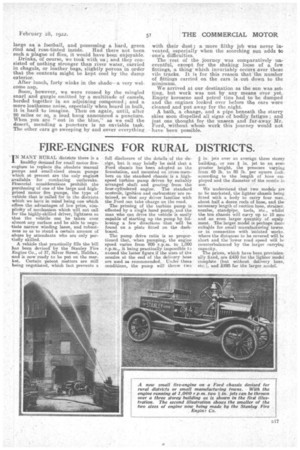FIRE-ENGINES FOR RURAL DISTRICTS.
Page 21

If you've noticed an error in this article please click here to report it so we can fix it.
IN MANY RITRAL districts there is a healthy demand for small motor fireengines to replace the obsolete manual pumps and small-sized steam pumps which at present are the only engines available for combating outbreaks. Financial considerations prohibit the purchasing of one of the large a..nd highpriced motor fire pumps, the type of vehicle that is called for in the districts -which we have in mind being one which offers the advantages of low price, simplicity of mechanism which will not call for the highly-skilled driver, lightness so that the vehicle can be taken over almost any surface and he able to negotiate narrow winding lanes, and robustness so as to stand a certain amount of abuse by attendants who are only partially skilled. A vehicle that praotic.ally fills the bill has been devised by the Stanley Fire Engine Co., of 37, Silver Street, Halifax, and is now ready to be pat on the market. Certain patent matters are still being negotiated, which fact prevents a
full disclosure of the details of the design but it may briefly be said that a Ford ohaseis has been adopted as the foundation, and mounted an cross-members on the standard chassis is a highspeed turbine pump driven by suitably arranged shaft and gearing from the four-cylindered engine. The standard centrals, ignition and carburetter are retained, so that any driver familiar with the Ford can take charge on the road.
The priming of the turbine pump is effected by a single hand pump, and the man who can drive the vehicle is easily capable of -starting up the pump by following a few directions that will be found on a plate fitted on the dashboard.
The pump drive ratio is so proportioned that, when pumping, the engine speed varies from 800 r.p.m. to. 1,000 r.p.m.' , it being practically impossible ta exceed the latter figure if the sizes of the nozzles at the end of the delivery hose are used as recommended. Under these conditions, the pump will throw two
in. jets over an average three storey
building, or one in. jet to an even greater height, the pressure varying from 40 lb. to 80 lb. per square inch. according to the length of hose employed and the diameter of the nozzle in
USO.
We understand that two models are to be marketed, the lighter chassis being fitted with a body to carry four men. about half a dozen reels of hose, and the necessary length of suction hose, strainer. nozzles, standpipe, tools, etc., whilst the ton chassis will caary up to 10 men and an even larger quantity of equip ment. The larger model is perhaps more suitable for small manufacturing tovrits or in connection with isolated works. where the distances to be covered will lac short and the 'lower road speed will be counterbalanced by the larger carry* capacity. The prices, which have been provisionally fixed, are £450 for the lighter model complete (but without delivery hose, etc.), and £495 for the larger model.






























